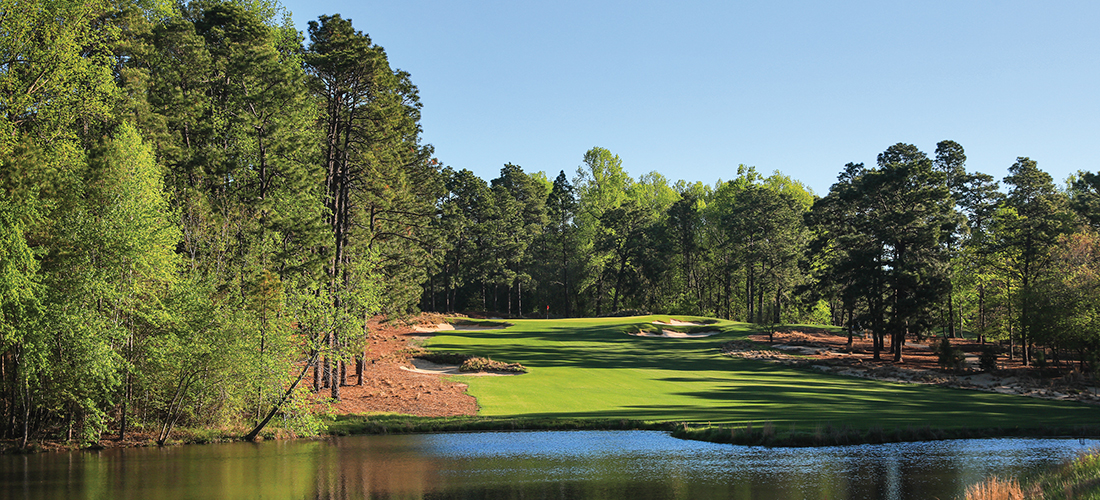
Pins and Needles
An old gem delivers a new test
By Lee Pace
The dominoes started falling in 2008 when Pinehurst Resort President Don Padgett II and USGA Executive Director Mike Davis were both of the opinion that Pinehurst No. 2 had evolved over time into a course that was too green, too smooth, too organized and too tidy. That led to the decision in 2009 to hire architects Bill Coore and Ben Crenshaw to recast the fairways, the rough and the bunkers into a presentation more consistent with what architect Donald Ross knew from his days as a young golfer and greenkeeper at Royal Dornoch Golf Club and the St. Andrews Links.
Jim Hyler, the incoming president of the USGA, threw down the gauntlet in February 2010 at the association’s annual meeting, held coincidentally at Pinehurst and just days before Coore and Crenshaw would begin surgery on No. 2.
“We must reset the way that we look at golf courses,” Hyler said. “As we have for the U.S. Open, I believe that our definition of playability should include concepts of firm, fast, and yes, even brown, and allow the running game to flourish. We need to understand how brown can become the new green.”
One of the shapers on the Coore and Crenshaw team was a young Oregonian named Kyle Franz, who had worked on bulldozers the world over, not only for Coore and Crenshaw but Tom Doak, Gil Hanse and other architects. Given a dollop of ambition and entrepreneurial spirit, Franz approached Kelly Miller, head of the ownership family of the Pine Needles and Mid Pines resorts in Southern Pines, and suggested similar overhauls to those classic Ross courses — like No. 2, layouts sculpted from the sandy soils in the early 1900s that over time had become too suffocated in long Bermuda grass. Miller accepted, and away Franz went to Mid Pines, engineering a remarkable face-lift that was finished in 2013 to rave reviews.
Mid Pines was now exquisitely framed with sand, wiregrass, ragged borders and an array of textures, and Franz began tinkering across Midland Road in 2016 on Pine Needles. The result will be on display in late May and early June, when the 2022 U.S. Women’s Open is held at Pine Needles for the fourth time. Its previous champions include Annika Sorenstam in 1996, Karrie Webb in 2001 and Cristie Kerr in 2007.
The banner headline: There will be essentially no rough on the golf course.
No rough at a U.S. Open? Egad. The starched shirts and rep ties are rolling over in their graves.
“I was looking at some photos from 2007, shots showing Cristie coming down the 18th fairway,” Miller says. “You had thick Bermuda everywhere you looked, all green grass. It’s quite a contrast now.”
The last time the Women’s Open was held at Pine Needles, a golfer could stand on the tee of the par-4 fourth hole, for example, and look to the left and see a round bunker with 10 yards of lush grass between the hazard and the fairway. What was the point of the bunker given the ball would rarely run though all the vegetation into it?
Now the bunker is amoeba shaped and juts into the fairway. The right side of the bunker is bordered by tight Bermuda fairway, the left by hardpan sand and pine needles. On the top of the bunker is a profusion of scraggly wiregrass. The fairway on both sides rolls straight into sandy waste areas. Gazing up toward the green, there is nothing that speaks of structure or organization.
“We’ve cleared out all the rough and now have sandscapes, hollows and hardpan,” Franz says. “There are some Pine Valley looks out there.”
Mid Pines opened in 1921 and Pine Needles followed in 1928, the former a lynchpin of a hotel and private club, the latter the drawing card for a hotel and new residential development. Franz marvels at how Ross built disparate layouts within the same footprint of what was known at the beginning as the Knollwood development.
“I love the contrasts between Mid Pines and Pine Needles,” Franz says. “Mid Pines is built more in a bowl, and a lot of balls get kicked back toward the center of the fairway. At Pine Needles, most of the strategic elements of the course are derived from the fact that you’re constantly trying to hit on top of a hill on the tee shot. That’s Ross’ genius with the routing.”
One-third of the holes at Pine Needles have crests running perpendicularly across the fairway. Hit into the slope on one, two, six, seven and 12, and you lose distance. Carry the high point and you get a slingshot boost toward the green. The 18th doesn’t have that ridge, but there’s definitely a speed slot you can catch with a tee ball curved right-to-left. And by expanding the fairway widths, the golfer has more latitude to aim tee shots one way or the other to afford a better angle to the pin on a particular day.
“The course will play firm and fast, the way it should play,” Miller says. “I think it will be fun for the golfers. Last year at the Olympic Club, if you missed the fairway, you were in the hay. There’s virtually no rough here. Kyle has revealed the genius of Ross’ routing — you have to hit to the proper side of the fairway. You can have a tough approach if you hit to the improper side.”
The final significant change to the course from previous Women’s Opens is the speed, firmness and articulations in the putting surfaces. The greens were converted in 2016 to MiniVerde Bermuda, following the trend throughout the Mid-Atlantic of the last dozen years to ride the wave of more heat-tolerant Bermuda grasses that don’t need the water and maintenance demands of summertime. Franz took the opportunity during the conversion to integrate what he calls “horse-and-blade caliber micro-contours” in the greens to add interest and challenge to the putting element.
“There aren’t any elephants buried in these greens, but Kyle put far more movement in them,” Miller says. “There are cool locations on all of them. I think the Bermuda greens and wider fairways will work well. In Ross’ era, golf was played more along the ground. Now it’s more in the air. But the Bermuda greens are firmer and offer a more challenging surface.”
USGA officials expect weekend crowds upward of 15,000 spectators, similar to the draw from 2007, but the corporate hospitality footprint will be more modest given that two years of COVID suffocation left the USGA and potential clients with no clarity of what late May and early June 2022 might allow.
But the vision for the golf course is razor sharp, a remarkable thing indeed for a layout now 94 years young. PS
Lee Pace has written about the Pinehurst-area golf scene for more than 30 years, including authoring Sandhills Classics — The Stories of Mid Pines & Pine Needles. Write him at leepace7@gmail.com and follow him @LeePaceTweet.





